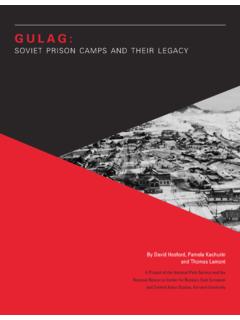Transcription of The 8 Stages of Genocide
1 The 8 Stages of Genocide By Gregory H. Stanton[i] The International Convention for the Prevention and Punishment of the Crime of Genocide defines " Genocide ." "In the present Convention, Genocide means any of the following acts committed with intent to destroy, in whole or in part, a national, ethnical, racial or religious group, as such: (a) Killing members of the group; (b) Causing serious bodily or mental harm to members of the group; (c) Deliberately inflicting on the group conditions of life calculated to bring about its physical destruction in whole or in part; (d) Imposing measures intended to prevent births within the group; (e) Forcibly transferring children of the group to another group." Acts of Genocide During the Rwandan Genocide , the State Department s lawyers infamously directed diplomats to avoid use of the word Genocide . Only acts of Genocide were being committed, they said. It was a distinction without a difference.
2 The crime of Genocide is defined by the Genocide Convention as "acts of Genocide ." It does not exist apart from those acts. A pattern of acts of Genocide is frequently called " Genocide " and evidence of such a pattern of ethnic, racial, or religious massacres is strong evidence of genocidal intent. The Convention declares the following acts punishable: "(a) Genocide ; (b) Conspiracy to commit Genocide ; (c) Direct and public incitement to commit Genocide ; (d) Attempt to commit Genocide ; (e) Complicity in Genocide ." The Genocide Convention is sometimes misinterpreted as requiring the intent to destroy in whole a national, ethnical, racial or religious group. Some genocides have fit that description, notably the Holocaust and Rwanda. But most do not. Most are intended to destroy only part of a group. The Genocide Convention specifically includes the intentional killing of part of a group as Genocide . It reaffirms this definition when it includes as among the acts that constitute Genocide "deliberately inflicting on the group conditions of life calculated to bring about its physical destruction in whole or in part'.
3 Those who shrink from applying the term " Genocide " usually ignore the "in part". Intent Intent can be directly proven from statements or orders by the perpetrators. But more often, it must be deduced from the systematic pattern of their acts, a pattern that could only arise out of specific intent. Criminal law distinguishes intent from motive. A murderer may have many motives -- gaining property or eliminating a rival for power. But his intent is determined by the purpose of his act: Did he purposely kill the victim? Genocidal intent is determined by the specific purpose of the act: Did the killer purposely kill the victim as part of a plan to destroy a national, ethnic, racial, or religious group, at least in part? The motive of the killer to take the victim's property or to politically dominate the victim's group does not remove genocidal intent if the victim is chosen because of his ethnic, national, racial, or religious group. A plan for Genocide doesn t need to be written out.
4 An act of Genocide may arise in a culture that considers members of another group less than human, where killing members of that group is not considered murder. This is the culture of impunity characteristic of genocidal societies. In Burundi, Tutsis who kill Hutus have seldom been convicted or even arrested. Massacres are ethnic, intended to destroy parts of the other ethnic group. Leo Kuper calls such mass killings genocidal massacres. They are acts of Genocide even if only a part of a group (the intellectuals, officers, leaders) is targeted. THE GENOCIDAL PROCESS Prevention of Genocide requires a structural understanding of the genocidal process. Genocide has eight Stages or operational processes. The first Stages precede later Stages , but continue to operate throughout the genocidal process. Each stage reinforces the others. A strategy to prevent Genocide should attack each stage , each process. The eight Stages of Genocide are classification, symbolization, dehumanization, organization, polarization, preparation, extermination, and denial.
5 Classification All languages and cultures require classification - division of the natural and social world into categories. We distinguish and classify objects and people. All cultures have categories to distinguish between us and them, between members of our group and others. We treat different categories of people differently. Racial and ethnic classifications may be defined by absurdly detailed laws -- the Nazi Nuremberg laws, the "one drop" laws of segregation in America, or apartheid racial classification laws in South Africa. Racist societies often prohibit mixed categories and outlaw miscegenation. Bipolar societies are the most likely to have Genocide . In Rwanda and Burundi, children are the ethnicity of their father, either Tutsi or Hutu. No one is mixed. Mixed marriages do not result in mixed children. Symbolization We use symbols to name and signify our classifications. We name some people Hutu and others Tutsi, or Jewish or Gypsy, or Christian or Muslim.
6 Sometimes physical characteristics - skin color or nose shape - become symbols for classifications. Other symbols, like customary dress or facial scars, are socially imposed by groups on their own members. After the process has reached later Stages (dehumanization, organization, and polarization) genocidal governments in the preparation stage often require members of a targeted group to wear an identifying symbol or distinctive clothing -- the yellow star. The Khmer Rouge forced people from the Eastern Zone to wear a blue-checked scarf, marking them for forced relocation and elimination. Dehumanization Classification and symbolization are fundamental operations in all cultures. They become steps of Genocide only when combined with dehumanization. Denial of the humanity of others is the step that permits killing with impunity. The universal human abhorrence of murder of members of one's own group is overcome by treating the victims as less than human.
7 In incitements to Genocide the target groups are called disgusting animal names - Nazi propaganda called Jews "rats" or "vermin"; Rwandan Hutu hate radio referred to Tutsis as "cockroaches." The targeted group is often likened to a disease , microbes , infections or a cancer in the body politic. Bodies of Genocide victims are often mutilated to express this denial of humanity. Such atrocities then become the justification for revenge killings, because they are evidence that the killers must be monsters, not human beings themselves. Organization Genocide is always collective because it derives its impetus from group identification. It is always organized, often by states but also by militias and hate groups. Planning need not be elaborate: Hindu mobs may hunt down Sikhs or Muslims, led by local leaders. Methods of killing need not be complex: Tutsis in Rwanda died from machetes; Muslim Chams in Cambodia from hoe-blades to the back of the neck ("Bullets must not be wasted," was the rule at Cambodian extermination prisons, expressing the dehumanization of the victims.)
8 The social organization of Genocide varies by culture. It reached its most mechanized, bureaucratic form in the Nazi death camps. But it is always organized, whether by the Nazi SS or the Rwandan Interahamwe. Death squads may be trained for mass murder, as in Rwanda, and then force everyone to participate, spreading hysteria and overcoming individual resistance. Terrorist groups will pose one of the greatest threats of genocidal mass murder in the future as they gain access to chemical, biological, and even nuclear weapons. Polarization Genocide proceeds in a downward cycle of killings until, like a whirlpool, it reaches the vortex of mass murder. Killings by one group may provoke revenge killings by the other. Such massacres are aimed at polarization, the systematic elimination of moderates who would slow the cycle. The first to be killed in a Genocide are moderates from the killing group who oppose the extremists: the Hutu Supreme Court Chief Justice and Prime Minister in Rwanda, the Tutsi Archbishop in Burundi.
9 Extremists target moderate leaders and their families. The center cannot hold. The most extreme take over, polarizing the conflict until negotiated settlement is impossible. Preparation Preparation for Genocide includes identification. Lists of victims are drawn up. Houses are marked. Maps are made. Individuals are forced to carry ID cards identifying their ethnic or religious group. Identification greatly speeds the slaughter. In Germany, the identification of Jews, defined by law, was performed by a methodical bureaucracy. In Rwanda, identity cards showed each person's ethnicity. In the Genocide , Tutsis could then be easily pulled from cars at roadblocks and murdered. Throwing away the cards did not help, because anyone who could not prove he was Hutu, was presumed to be Tutsi. Hutu militiamen conducted crude mouth exams to test claims of Hutu identity. Preparation also includes expropriation of the property of the victims. It may include concentration: herding of the victims into ghettos, stadiums, or churches.
10 In its most extreme form, it even includes construction of extermination camps, as in Nazi-ruled Europe, or conversion of existing buildings temples and schools into extermination centers in Cambodia. Transportation of the victims to these killing centers is then organized and bureaucratized. Extermination The seventh step, the final solution, is extermination. It is considered extermination, rather than murder, because the victims are not considered human. They are vermin, rats or cockroaches. Killing is described by euphemisms of purification: ethnic cleansing in Bosnia, ratonade (rat extermination) in Algeria. Targeted members of alien groups are killed, often including children. Because they are not considered persons, their bodies are mutilated, buried in mass graves or burnt like garbage. Denial Every Genocide is followed by denial. The mass graves are dug up and hidden. The historical records are burned, or closed to historians.





